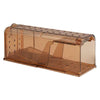Step 1 - Choose a Pumpkin Variety
There are many varieties of pumpkins out there in the world, but not all are well-suited for container growing. It’s best to stick with mini or smaller pumpkin types to make sure they don’t completely take over your patio or deck. Here are a few pumpkin options that are perfect for container gardens.
Miniature or Small Pumpkins
- Jack Be Little: mini orange pumpkins that grow to be 2-3 inches in diameter
- Baby Boo: mini white pumpkins that grow to be 2-3 inches in diameter
- Munchkin: mini orange pumpkins that are about 4 inches in diameter
Pie Pumpkins
- Sugar Pie: small, sweet pumpkins that grow to be 6-8 inches in diameter
- Small Sugar: another sweet pumpkin similar to sugar pie pumpkins that are great for baking
Bush Pumpkins
- Bushkin: medium-size pumpkins that require less sprawling space than traditional pumpkins
- Wee-B-Little: compact plant that grows tiny pumpkins

Step 2 - Choose a Container
To ensure your pumpkin harvest is successful, it’s important to select a container that is large enough to support their growth. Pumpkins have extensive root systems and need plenty of space to grow, so choosing a planter with an interior depth of at least 18 inches is best. The minimum recommended container size for smaller pumpkin varieties is 20-25 gallons, and the minimum recommended container size for larger varieties is 30 gallons. No matter the variety, choose a planter with drainage holes to prevent water from pooling and causing root rot. Garden beds are also a great option for growing pumpkins in a confined space. Just be sure the bed has drainage holes and a deep interior.
Step 3 - Prepare the Soil
Once you’ve found the perfect container, it’s time to fill it with soil. Use a high-quality potting mix that is light, well draining, and nutrient rich. You can also mix in organic matter like compost or a slow-release fertilizer to increase the fertility of the soil and add more nutrients.

Step 4 - Planting the Seeds
The next step is to plant the pumpkin seeds in the soil. Push 2-3 seeds about an inch into the soil, making sure to space them evenly. After the seeds begin to sprout, you can thin out the weaker seedlings to make more room for the stronger seedlings to grow.
Tip: You can also start seeds indoors a few weeks before the last frost date and then transfer them into the container (or just move it outdoors) once temperatures increase. Wrap the seeds in a damp cloth or paper towel then place that in a plastic bag. Set the seeds in a warm place indoors and when you see a sprout begin, plant them in a container.
Step 5 - Water the Seeds
Pumpkins require consistent moisture, especially when they’re grown in containers because the soil dries out faster. Water the plant when the top inch of the soil feels dry. It’s best to deep water, but take care not to waterlog the soil. Water the plants early in the morning to reduce evaporation and allow the leaves to dry off.
Tip: Adding a layer of mulch to the container can help conserve moisture and keep the soil temperature stable.
Step 6 - Position the Container
Now that your seeds are planted and watered, it’s time to find the perfect location to place the pumpkin container. Put it in a spot where the plant will get at least 6-8 hours of direct sunlight every day. Full sun is essential for the plant’s growth. If you’re growing a bush variety, try adding a trellis to the pot to support some of the leaves and vines as the plant grows.
Step 7 - Fertilize After Growth
Once the pumpkin plant starts to vine and grow, feed the plant every 2-4 weeks or follow the instructions on the fertilizer bottle. Use a fertilizer that is high in phosphorus and potassium to promote flowering and fruiting. A 5-10-10 NPK mix should work perfectly!
It’s also important to watch out for common pests like aphids, cucumber beetles, and squash vine borers. Try using an organic insecticidal soap or neem oil to keep these bugs out of your pumpkin plants.

Step 8 - Pollinate as Needed
If your pumpkins are flowering but not growing any fruit, you might have to hand-pollinate the plants. Use a cotton swab to transfer pollen from the male flowers (the ones without fruit at the base) to the female flowers (the ones with a small fruit at the base). This will help your plants to produce pumpkins faster.
Step 9 - Prune the Vines
To keep the pumpkins from getting out of control, it may be necessary to prune back excessive vines, especially if you’re growing a larger pumpkin variety. This helps direct more energy into growing a few high-quality pumpkins and keep the plant from taking over areas outside of the container. If you’re using a trellis, be sure the vines are secure and support any pumpkins with a sling or netting.
Step 10 - Harvest the Pumpkins
Now that your pumpkins have fully grown it’s time to harvest them! Your hard work has paid off! Most pumpkins are ready for harvest between 90 and 120 days after planting. Be sure the pumpkins are ripe by checking that the skin is hard and doesn’t dent when you press it and that the color is fully developed. Use pruning shears to cut the pumpkin from the vine cleanly. Leave about 2-4 inches at the top for the stem. All that’s left to do is enjoy your pumpkins!
By following these steps and providing plenty of sunlight and water, your container-grown pumpkins should thrive! Check out our other gardening tips in our Bright Idea Blogs for more inspiration.




























































